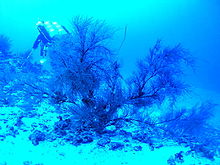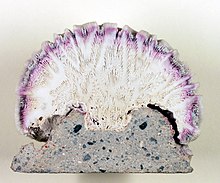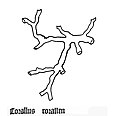coral
As coral (from ancient Greek κοράλλιον Korallion "Coral") are sessile , colony-forming cnidarians (Cnidaria), respectively. The different groups of corals are not closely related to each other, but belong to different taxa of the cnidarians. The best known are the hard corals (Scleractinia), which have a major share in the development of coral reefs . Another important, species-rich group are the octocorals (Octocorallia), to which the soft , leather and tube corals as well as the gorgonians belong. The black corals (Antipatharia) are much poorer in species with around 235 species. While the groups mentioned so far are flower animals (Anthozoa), the fire ( Millepora ) and filigree corals (Stylasteridae) belong to the class of Hydrozoa .
In addition to the recent (now living) rugosa and tabulata are extinct coral groups. ( See also: Corals of the Swabian Alb .)
The coral is often only the skeleton of the white or red coral ( Corallium rubrum , synonym: Madrepora oculata , Gorgonia nobilis ).
Biology / natural sciences
General
Corals are found only in the sea , especially in the tropical belt . In terms of growth form, a distinction is made between soft corals and stony corals , the latter forming skeletons through the accumulation of lime , through which coral banks or a coral reef are created, as dead skeletal material is continuously overgrown by living tissue. Coral skeletons consist mostly of aragonite , which the coral animals secrete from their foot disk or their ectoderm to give support to the colony. The individual skeletons are usually branched like plants and at the ends of the branches, the growth tips , there are often colorful polyps , which also give the impression that corals are undersea flowering plants.
As with most sessile (= fixed) marine animals, corals are also filter feeders , i. That is, they also feed by filtering out microplankton , nutrients and trace elements from the current-rich seawater. However, many of the corals that live near the surface of the water do not feed by filtering plankton alone, but also (or even to a greater extent) by endosymbionts , i.e. H. Symbiotic algae , so-called zooxanthellae , embedded in the polyp cells , which also cause the intense colors in the living tissue of the coral. These unicellular algae are seamlessly integrated into the coral's nutrient balance with their photosynthesis metabolism. Depending on the plankton present, the size of the coral polyps can be very different, so a distinction is made between large polyps (LPS - Large Polyp Sclerantinia) and small polyps (Small Polyp Sclerantinia), with the polyp size varying from fractions of a millimeter to several centimeters. Corals have been around for over 400 million years; they help the geologist with palaeoclimate reconstructions (see also: Scale age determination (biology) ).
Cold water corals
In addition to the hard corals of the tropics, you can also find cold water corals (or deep sea corals). They have no zooxanthellae and feed exclusively by filtering plankton. They have only been researched in more detail since the 1990s. Since then, they have been detected in all oceans (including the Mediterranean, but not in the Black Sea and not in the Baltic Sea) at depths of 40 m (New England Seamount Chain) up to 3383 m (North Atlantic) at temperatures of 4 to 12 ° C; However, they mainly occur at depths between 100 and 200 m below the wave influence area.
Until 2007, a four-digit number of deep water coral species was known, which mainly belong to the fire corals , octocorallia , hard corals , filigree corals and black corals . The dominant reef-building species Lophelia pertusa and the oculinidae scoring Madrepora oculata . Cold water coral reefs can be found below the wave range, i.e. below 100–300 m. Like their near-surface relatives, they then provide a habitat for a diverse fauna. Around 4,000 animal species have been identified in the cold-water coral reefs.
Reproduction
Please refer:
Danger
The algae (zooxanthellae) mentioned above are very sensitive to temperature. If the water warms up too much, they start to produce toxins and are then repelled by the corals. The white chalk coat remains, hence the term coral bleaching . By global warming are more frequent and longer lasting to the "overheating" of sea water. As a result, coral bleaching, which is otherwise easy, from which a colony can recover, is more difficult and ultimately leads to death.
The acidification of the seas , which absorbs part of the anthropogenic emissions of carbon dioxide , which inhibits the formation of new limestone shells, poses a further danger . If the carbonate compensation depth increases due to acidification , deep-water corals are also endangered.
The discharge of feces also seems to be a factor in coral bleaching, as it could be observed more frequently in corresponding places. Coliform bacteria are suspected to be the trigger in the faeces. Coral bleaching has destroyed many popular diving areas in recent years . Even if it is not yet certain at what temperature the reefs die due to the above-mentioned human activities, coral reefs in warm areas are already showing the first symptoms of an irreversible change in the ecosystem (status 2015). In 2016, the heaviest coral bleaching ever measured in the Great Barrier Reef severely damaged 55% of the reefs, compared to only 18% in the previous two heavy bleaches in 1998 and 2002. In 2016, 93% of all reefs there were affected by the bleaching.
In a laboratory study it could be shown that some coral species are affected by microplastics .
Deep-sea corals are threatened by deep-sea fishing ( trawling and bottom-net fishing ). A negative influence from drilling platforms for oil or natural gas production in the vicinity of cold water coral reefs cannot be ruled out. Submarine transcontinental telecommunications cables are also a threat.
protection
For several decades, enthusiasts such as Wolf Hilbertz , Tom Goreau or the Global Coral Reef Alliance have been trying to counteract the destruction of coral reefs. They create national parks in the seas and try to create artificial coral reefs and preserve dying reefs. A wide variety of methods were used, such as the reef ball , biorock technology , the sinking of ships, aircraft and vehicles. An artificially created reef made of submerged car tires ( Osborne reef ) has developed into an ecological catastrophe in the USA.
Use
The calcareous axial skeletons of some octocorals and black corals are used for jewelry making. This use can be proven back to prehistoric times. The red coral is the most sought-after gemstone . However, the living corals are more important as a breeding ground and nursery for many sea creatures. Here they find protection from their enemies and enough food. Around a quarter of all known marine fish exist in the coral habitat.
Customs, symbolism, iconography and medicine
Corals and coral branches, mainly red in color, were already used for amulets in ancient times. They were seen as protection against disease, lightning strikes and malformation. They were in ancient Egypt of Isis and in Rome the Venus holy. Coral rosaries ("paternoster claws") were very popular in the post-Middle Ages. In Italian popular belief, corals protect children from harm. That is why there are many depictions of the baby Jesus with a coral necklace and a collar with a coral branch. In secular iconography , the coral necklace has become an attribute of childhood . In the story "Der Leviathan" by Joseph Roth , the coral plays a central symbolic role.
The medicinal use of the calcareous skeletons of corals is also documented in the Middle Ages. They were used, ground into powder, in potions for spleen and urinary stone problems.
history
swell
- Antiquity - late antiquity: Dioscurides 1st century
- Arab Middle Ages: Avicenna 11th century --- Constantine 11th century --- Circa instans 12th century --- Pseudo-Serapion 13th century
- Latin Middle Ages: Konrad von Megenberg 14th century --- Herbarius Moguntinus 1484 --- Garden of Health 1485 --- Hortus sanitatis 1491
- Modern times: Hieronymus Brunschwig 1512 --- Paracelsus approx. 1525 --- Mattioli / Handsch / Camerarius 1586 --- Pierre Pomet 1694 --- Nicolas Lémery 1699/1721 --- Onomatologia medica completa 1755 --- William Cullen 1789/90 --- Jean-Louis Alibert 1805/05 --- Hecker 1814/15 --- Pereira / Buchheim 1846/48 --- Theodor Husemann 1883
Historical illustrations
Vienna Dioscurides 6th century
Garden of Health 1485
Hortus sanitatis 1491
Mattioli / Handsch / Camerarius 1586
Pierre Pomet 1694
literature
- Carl Vogt : The jewelry of the sea . In: The Gazebo . Issue 3 and 21, 1866, pp. 40–42 and 326–328 ( full text [ Wikisource ] - corals and coral fishing, with illustrations).
- Otto Lagercrantz , Hugo Blümner , Hans Gossen , August Steier : Coral . In: Paulys Realencyclopadie der classischen Antiquity Science (RE). Volume XI, 2, Stuttgart 1922, Sp. 1373-1377.
- Elfriede Grabner: The coral in folk medicine and popular belief. In: Zeitschrift für Volkskunde , 65, 1969, pp. 183-195.
Web links
- www.fao.org: Corallium rubrum (Linnaeus, 1758)
Individual evidence
- ↑ a b c Lich Barbara and Solvin Zankl: Korallen. In the fjord? Geo, June 2013, pp. 70–84.
- ↑ a b c d J Murray Roberts, Stephen D Cairns: Cold-water corals in a changing ocean . In: Current Opinion in Environmental Sustainability . April 2014, doi : 10.1016 / j.cosust.2014.01.004 .
- ^ Andreas Heitkamp: Cold water corals - "Great Barrier Reef" of the north . In: Nadja Podbregar, Dieter Lohmann (Ed.): In Focus: Marine Worlds (= natural sciences in focus https://link.springer.com/bookseries/10114 ). Springer, 2014, ISBN 978-3-642-37719-8 , doi : 10.1007 / 978-3-642-37720-4_8 .
- ↑ Ottmar Edenhofer , Susanne Kadner, Jan Minx: Is the two-degree target desirable and can it still be achieved? The contribution of science to a political debate. In: Jochem Marotzke , Martin Stratmann (Hrsg.): The future of the climate. New insights, new challenges. A report from the Max Planck Society. Beck, Munich 2015, ISBN 978-3-406-66968-2 , pp. 69–92, here p. 75.
- ↑ Great Barrier Reef: 93% of reefs hit by coral bleaching . In: The Guardian , April 19, 2016. Retrieved May 5, 2016.
- ↑ Microplastics damage corals: JLU Gießen involved in study. In: giessener-anzeiger.de . September 21, 2019, accessed September 28, 2019 .
- ^ Anton Trutmann: Pharmacopoeia. (Hs. XI. 61 of the Burgerbibliothek Bern). Edition by Rainer Sutterer: Anton Trutmann's 'Pharmacopoeia', Part I: Text. Medical dissertation Bonn 1976, sheet 51 ("dem boeßen milczen: do drink coral powder with water") and 74 ("powder for grienn [...]. And never know claws").
- ↑ Pedanios Dioscurides . 1st century: De Medicinali Materia libri quinque. Translation. Julius Berendes . Pedanius Dioscurides' medicine theory in 5 books. Enke, Stuttgart 1902, p. 542 (Book V, Chapter 138): Korallion (digitized version )
- ↑ Avicenna , 11th century: Canon of Medicine . Translation and adaptation by Gerhard von Cremona , Arnaldus de Villanova and Andrea Alpago (1450–1521). Basel 1556, Volume II, Chapter 123: Corallus (digitized version )
- ↑ Constantine the African , 11th century: Liber de gradibus simplicium . Pressure. Opera . Basel 1536, p. 354: Corallus (digitized version )
- ↑ Circa instans 12th century print. Venice 1497, pp. 194v – 195r: Corallus (digitized)
- ^ Pseudo-Serapion 13th century, print. Venice 1497, sheet 112v – 113r (No C): Corallus (digitized)
- ^ Konrad von Megenberg , 14th century: Book of nature. Output. Franz Pfeiffer . Aue, Stuttgart 1861, p. 439 (VI / 15 - "Von den Stainen"): Corallus (digitized version )
- ↑ Herbarius Moguntinus , Mainz 1484, Part II, Chapter 66: Corallus rubeus et albus (digitized version )
- ↑ Gart der Gesundheit . Mainz 1485, chapter 130: Corallus. Corals (digitized)
- ↑ Hortus sanitatis 1491, Mainz 1491, Part V (De lapidibus), Chapter 42: Corallus (digitized version )
- ↑ Hieronymus Brunschwig : Liber de arte distillandi de compositis . Johann Grüninger, Strasbourg 1512, sheet 209r – 209v: Corallus (digital copy )
- ↑ Paracelsus : Herbarius , approx. 1525. In: Huser edition of the works of Paracelsus, Basel 1590, part 7, pages 93–100: De corallis (digitized version )
- ^ Pietro Andrea Mattioli : Commentarii, in libros sex Pedacii Dioscoridis Anazarbei, de medica materia. Translation by Georg Handsch, edited by Joachim Camerarius the Younger , Johan Feyerabend, Franckfurt am Mayn 1586, sheet 399ra –400r: Meermooß (digitized version )
- ↑ Pierre Pomet : Histoire générale des drogues, traitant des plantes, des animaux, & des mineraux; ouvrage enrichy de plus de quatre cent figures en taille-douce tirées d'aprés nature; avec un discours qui explique leurs differens noms, les pays d'où elles viennent, la maniere de connoître les veritables d'avec les falsifiées, & leurs proprietez, où l'on découvre l'erreur des anciens & des modern ... par le sieur Pierre Pomet .... Jean-Baptiste Loyson & Augustin Pillon Paris 1694, pp. 162–165: Corail (digitized version)
- ↑ Nicolas Lémery : Dictionnaire universel des drogues simples. , Paris 1699, pp. 218-220: Corallum (digitized) ; Translation. Complete material lexicon. Initially drafted in French, but now after the third edition, which has been enlarged by a large [...] edition, translated into high German / By Christoph Friedrich Richtern, [...]. Leipzig: Johann Friedrich Braun, 1721, Sp. 341–344: Corallum (digitized)
- ↑ Albrecht von Haller (editor): Onomatologia medica completa or Medicinisches Lexicon which explains all names and artificial words which are peculiar to the science of medicine and the art of pharmacy clearly and completely [...]. Gaumische Handlung, Ulm / Frankfurt am Main / Leipzig 1755, Sp. 479–483: Corallia (digitized version )
- ^ William Cullen : A treatise of the materia medica. Charles Elliot, Edinburgh 1789. Volume II, p. 420: Corallium and Corallina (digitized) . German. Samuel Hahnemann . Schwickert, Leipzig 1790. Volume II, p. 465 (digitized version)
- ^ Jean-Louis Alibert : Nouveaux éléments de thérapeutique et de matière médicale. Crapart, Paris Volume I 1803, pp. 403–404: Coralline officinale (digital copy )
- ↑ August Friedrich Hecker 's practical medicine theory. Revised and enriched with the latest discoveries by a practicing doctor . Camesius, Vienna, Volume II 1815, p. 459 (digitized version )
- ↑ Jonathan Pereira’s Handbook of Medicines Doctrine. From the point of view of the German Medicin edited by Rudolf Buchheim . Leopold Voss, Leipzig 1846-48, Volume I 1846, p. 560: Carbonate of lime ... Corallium rubrum (digitized)
- ^ Theodor Husemann : Handbook of the entire drug theory. Springer, Berlin 2nd edition 1883, p. 401: Korallen (digitized version)










